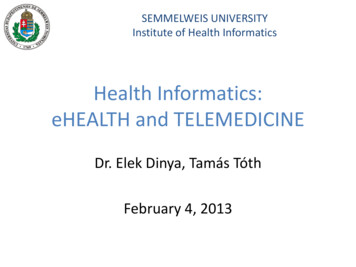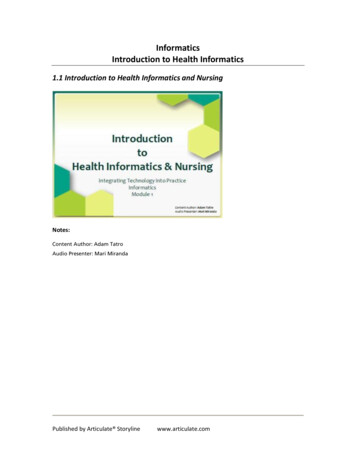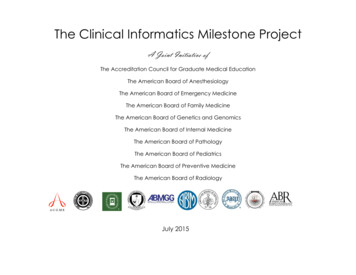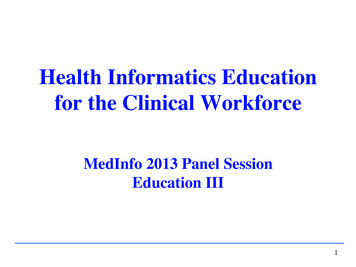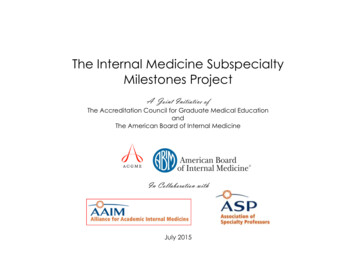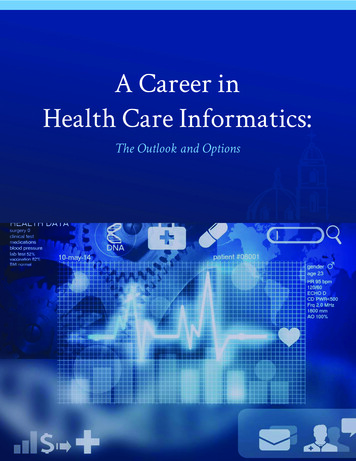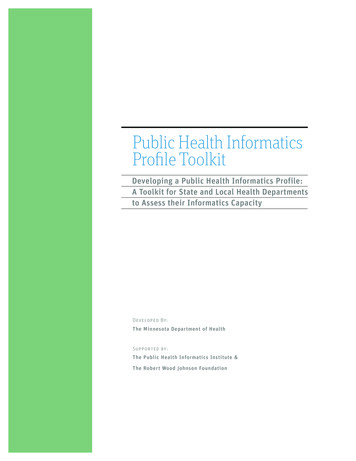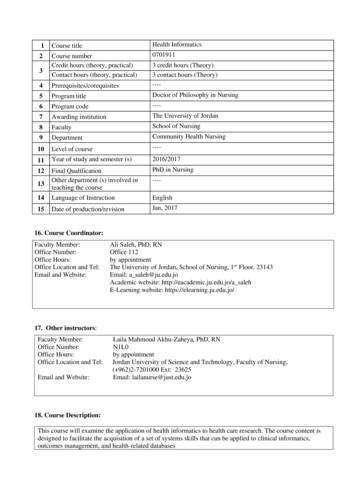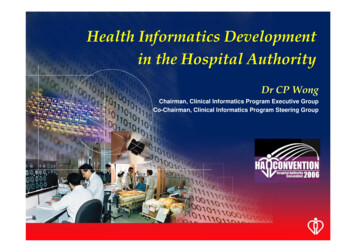
Transcription
Update on Clinical InformaticsSubspecialtyDoug Fridsma MD, PhD, FACP, FACMIPresident & CEO AMIAamia.orgwww.amia.org
THE YEAR‐IN‐REVIEWABPM 2016amia.org
AMIA activities Quarterly in‐person meetings with ABPM and ABMS officials– Concern regarding updates to the core content– MOC activities (applications for novel approaches)– Coordination with other certification and accreditation activities ACGME (graduate medical education) CAHIIM (MS health informatics programs) AHIC (advance health informatics certification)amia.org
THE FALL 2016 EXAMamia.org
Complete quality breakdown Wrong examination (a non‐approved, draft examination)uploaded to Pearsons Stem without questions Typos Questions without correct answers ABPM had not scaled its processes appropriately to meet thedemand of the CI board or the addiction medicine boardamia.org
THE AFTERMATHamia.org
ABPM 2017 Executive Director resigned Interim director: Ben Munger Change from Pearson’s to USMLE provider for examination Realized:– No communication of AMIA concerns to the ABPM board– No internal quality controls or communications– Governance without appropriate clinical informatics inputamia.org
THE NEW ORDERamia.org
ABPM 2017 Spring examination without complaints ABMS is monitoring Ongoing conversations with ABPM and AMIA (monthly andsometimes more)– Increased communication with AMIA and ABPM ED and board– Integration of ABPM board into plans for core content and programrequirement updates Update to core content (driven by best practices and workanalysis)amia.org
THE SURVEYamia.org
AHIC Workforce Survey Strategies Survey entire informatics workforce (addedbonus opportunity to engage everyone in informatics ratherthan create sense of being left out again) Constant/creative messaging to AMIA members Work with other organizations Incentive Took broad approach to who is doing informatics and askedpeople to describe what they doamia.org
Informatics Workforce SurveyPreliminary Results 2300 completed surveys with broadrepresentation What does the sample look like? All results reported here are preliminaryamia.orgwww.amia.org
Q118: Are you or have you ever been amember of AMIA? Answered: 2,352 Skipped: 0amia.org
Q1: Please indicate which of the followinginformatics domains represents your area(s) ofwork or study. Choose all that apply. Answered: 2,352 Skipped: 0amia.org
Q4: Please indicate your primary informaticsrole: Answered: 2,274 Skipped: 78amia.org
Q5: Please indicate yoursecondary informatics role, if applicable: Answered: 1,702 Skipped: 650amia.org
Q114: Which of the following best describes the organizationwhere you currently perform most of your health informaticswork? Choose all that apply. Answered: 2,232 Skipped: 120amia.org
THE CURRENT SNAPSHOTamia.org
Board‐certified Clinical InformaticiansCohortABPMPathology1. 2024 recertification432242. 2025 recertification304253. 2026 recertification303174. 2027 recertification35325TOTALS1392911483 board‐certified clinicalinformaticians in the US19amia.org1
The pipeline 29 ACGME programs so far (Goal is 50‐75) Program acceleration– Foundation funding for new programs– Resources for program directors Medical schools– Meeting with AAMC, NBME, AMA, others– Need additional resources to get clinical informatics into thecurriculumamia.org
KEEPING UPamia.org
AMIA’s CME Program Live Meetings Webinars 10x10 courses in partnership withuniversities Clinical Informatics Board Review Course 2017: online learning ateducation.amia.org1amia.org22
MOC Program Provider of MOC‐II credits for board‐certified clinical informaticiansrigorous peer‐reviewed MCQs in accordance with NBME guidelinesALWAYS looking for partners with our MOC activitiesYearActivity# MOC‐II Credits2014Annual Symposium212015iHealth6Annual Symposium2016iHealth2017Annual SymposiumiHealth25.51225.51723107amia.org1
Webinars Working Group (WG) – sponsored 35 webinars in 2016 JAMIA Journal Club Monthly: 11 in 2016 Live webinar for CME credit24amia.org1
10x10 Courses 22 courses completed in 2016 11 completed as of 6/14/2017 46 – 54 CME credit for most Minnesota CNE Partnerships with Duke, IUPUI, Kansas UMC, NovaSoutheastern, OHSU, OSU, Stanford, UAB, U ofMinnesota, U of Utah Topics range from introductory topharmacogenomics Outcomes‐based: capstone projects for most1amia.org25
Clinical Informatics Board ReviewCourse (CIBRC) 2013 first year of board certification exam 10 board review live meetings completed by2016 987 physicians educated through 2016 Online course plus 200‐MCQ simulated exam 935 physicians educated onlinethrough 2016 (some overlap with live meetings) CIBRC V in 201726amia.org1
Learning Management System Next generation of informatics education from AMIA Launching in 2016 Multiple formats: Short coursesMultiple‐module coursesJournal‐based CME (JAMIA)WebinarsPodcasts Education for CME, MOC‐II, and CNE credit and for gainingknowledge; activities on policy and leadership Clinical Informatics content will be first content to go‐live27amia.org1
ADVOCACYamia.org
Supporting the Clinical InformaticsCommunity in Washington DC In the Past Year – Members of our Applied Clinical Informaticscommunitysubmitted recommendations to: FDA – Real‐World Data using EHRs CMS – Meaningful Use / Advancing CareInformation ONC – Measuring Interoperability OHRP – Secondary research by HIPAA coveredentities CDC – CDS at the intersection of care andsurveillanceamia.org
Published Policy Prioritiesamia.org
MACRA NPRM (current as of 4pm EST) The key policy questions for this NPRM are– how will the ACI measures / objectives and scoring methodologychange, and– what will the CEHRT requirements and reporting period be? In both instances, CMS has proposed a reasonable set ofrequirements that both encourage continued adoption andfocus on health IT‐enabled care, while also addressingpotential concerns with the timeline for adoption of CEHRT.amia.org
ACI measures/objectives and scoringmethodology No change to the required measures/objectives (Page 190) Overall, there are more chances for ECs to garner bonuspoints – either through expanded improvement activities orthrough a more generous policy around public health /clinical data registry reportingamia.org
CEHRT requirements and reporting period The proposal loosens requirements to use 2015 EditionCEHRT in 2018, but proposes bonus points for those who do(no points for those who use a combination) ECs can continue to use 2014 Edition CEHRT, a combinationof 2014 and 2015 CEHRT, or use 2015 Edition CEHRT They continue the 90‐day reporting period for this year andpropose the same for next year.amia.org
Overall AMIA impression CMS has proposed a set of policies that provide flexibility inCEHRT and reporting period, while also encouraging moreadvanced use of health IT to support patient care – such asAPIs, patient generated health data and clinical informationreconciliation.amia.org
THE WORK AHEADamia.org
Informatics Employer Survey Current and future demand for informaticsprofessionals Challenges employers face in hiring informaticsprofessionals Employers’ perceptions of informatics certificationSurvey Open June 7 – June org
Informatics Education Program SurveyTypes and sizes of current and planned informaticseducational programs in the U.S. as a first step inestimating the pipeline for future informaticsprofessionals.Survey Open June 7 – June a.org
Update to Core Content and Programrequirements Clinical informatics Program directors (CCIPD)– Updating program requirements (to support ACGME accreditation) Clinical Informatics Community of Practice (CICOP)– Update Core content (to support examination update)– Coordinate with ABPM and with AHIC activities AMIA with clinical informatics fellows, program directors, anddiplomates– Fostering community within clinical informatics fellows, programdirectors and diplomates– Advocacy for pipeline development– Recognition programs for applied informaticsamia.org
QUESTIONS?amia.org
amia.org
Q7: What is your primary health domain? Answered: 2,000 Skipped: 352amia.org
10x10 Real Quotes “Great information presented in a logical manner. Helped me learn a lot of informationrelated to medically specific IT.” “I learned the theoretical components of health informatics and that gave me a deeperunderstanding of what I was doing in practice and why.” “Basic Knowledge of complexity of a large multi hospital informatics network helped meget new job.” “The unit that included Telemedicine inspired me to research this area more, and I amnow a Telemedicine provider of patient care” “I can now communicate with informatics professionals/hospital IT admin using theirlanguage and understand their terminology as I work on informatics projects” “The 10x10 opened many doors for me to make a transition to the field of informatics. Istill refer back to my notes and articles from the course. Gave me a solid understandingof the many facets of informatics” “I am helping kick off a Clinical Informatics Fellowship at XXX It was due to this coursethat I managed to persuade the Chair of Medicine to start the Clin Inf Section .Knowing about Meaningful Use, and lots of the acronyms and jargons typical of BMIhave helped open new collaborations and research efforts. We migrated to ICD10 withthe drugs database and moved into controlled vocabularies for drugs ‐ direct results ofthe 10x10 course.”1amia.org42
Live Meetings Annual symposium 2300 attendees in 2016 25.5 hours CME, MOC‐II, and CNE credit 193 diplomates claimed 3093 MOC‐II credit hoursusing 800 multiple‐choice self‐assessment questions 18 pathologists claimed MOC‐II creditJoint Summits 530 attendees in 2017 24 hours CME and CNE creditiHealth 288 attendees in 2017 20.75 hours CME and CNE; 17 MOC‐II credits 61 diplomates claimed 727 MOC‐II credit hours using 130 MCQs 4 pathologists claimed MOC‐II credit1amia.org43
AMIA’s Education Program Scientific rigor Growth Based on identified educational gapsand needs Leading authority for the mostup‐to‐date biomedical and healthinformatics education44amia.org1
Clinical Informatics Board Review Course (CIBRC) 2013 first year of board certification exam 10 board review live meetings completed by 2016 987 physicians educated through 2016 Online course plus 200‐MCQ simulated exam 935 physicians educated online through 2016 (some overlap with live meetings)
